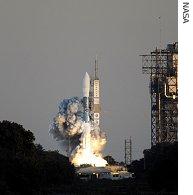2007年VOA标准英语-NASA Mission to Seek Polar Lights' Energy Sourc(在线收听)
Washington
18 February 2007
The U.S. space agency NASA has launched five satellites - the most ever from one rocket - to locate the source of energy in Earth's magnetic field that triggers the colorful, dancing auroras over the north and south poles. As we hear from VOA's David McAlary, a finding would help scientists better understand how gigantic storms on the sun that supply this energy disrupt electrical systems on Earth and in spacecraft.
 |
| The Delta II rocket with NASA's THEMIS spacecraft aboard lifts off |
Despite their visual appeal, these brilliant light shows are storms - geomagnetic storms. Scientists call them substorms, a part of larger storms of energy propelled from the sun at supersonic speeds toward Earth and elsewhere in the solar system.
This energy involves tons of charged particles, hurled our way in the so-called solar wind. Earth's magnetic field repels most of this onslaught, but some occasionally leaks through as a result of a sudden, explosive release of these particles from the solar wind.
The outcome is the light shows over the poles and sometimes the undesirable disruption of electrical power systems and telecommunications on Earth and spacecraft in orbit.
Solar physicist Vassilis Angelopoulos of the University of California at Berkeley says the precise point in Earth's magnetic field where this explosive particle release occurs and the sequence of events leading to it have puzzled scientists for three decades. "Knowing the trigger location identifies the correct physics at play. The problem has been that the substorms start at a single point in space, somewhere near Earth, and, within minutes, it progresses past the moon's orbit, so a single satellite alone cannot identify the substorm time and point of origin," he said.
To seek the answer to this mystery, NASA has launched five satellites aboard a Delta rocket from Florida to train their instruments on the northern and southern lights. The project is called THEMIS.
Once in orbit, two of the THEMIS spacecraft will circle Earth about one-sixth the distance to the moon while the other two circle half way to the moon. A fifth will be a reserve, if one of the others fails during the two-year mission.
Angelopoulos says a finding will help scientists know more about the threatening solar storms and how our planet's magnetic field works. "Understanding and predicting space storms is important for protecting our satellites and astronauts in space. Meteorologists study tornadoes to understand the most severe thunderstorms, and we, too, want to study substorms to gain insight into the most intense space storms," he said.
Cramming five miniature satellites into the nose of one launch rocket has had a collateral engineering benefit. Each is a cube, less than one meter wide and high. The THEMIS project manager at the University of California, Peter Harvey, says it has taught technicians how to make small satellites with little computers and other instruments. "It has been a challenging project to pack so much into five small spacecraft. We learned a lot about how to build a constellation of spacecraft. We look forward to some terrific scientific discoveries," he said.